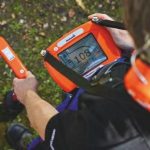The oscilloscope is described as a versatile electronic device which is used in many industries and specific branches. This device is used by physicians, electronic technicians, engineers, auto repair technicians and health care workers.
What Is An Oscilloscope?
It is an electronic instrument which is generally used for measuring time-varying signals. This device displays and analyzes the waveform of the electronic signals by drawing a graph of the instantaneous signal voltage as a function of time. The oscilloscope has a simple working principle: it measures the signals by displaying either alternating current (AC) or a direct current (DC) wave-forms with a frequency from minimum 1 hertz (Hz) up to several hundred megahertz and gigahertz, depending on the oscilloscope type.

The oscilloscope has been invented in 1987, by the great German physician Karl Ferdinand Braun. The oldest laboratory oscilloscope is the cathode-ray oscilloscope, which can be still seen in some laboratories, Today, the two most commonly used oscilloscopes are the analog and the digital oscilloscope. Several factors need to be considered before choosing the ideal oscilloscope for your applications, such as: number of channels, bandwidth, memory depth, sampling rates, display capacity, connectivity and analysis capability.
Analog Oscilloscope Explained
Although both oscilloscopes serve for displaying and analyzing the waveform of electronic signals, the analog oscilloscope has bigger triggering capability and comes with more advanced mechanic switch. The analog oscilloscope displays the electronic signals as they happen. Compared to the digital oscilloscope, the analog oscilloscope has larger bandwidth and an exceptional capability of displaying clear readable traces even at high sweep speeds.
Digital Oscilloscope Explained
This model is more popular that the analog oscilloscope, and it is used for many industrial applications. The main reason for that is the memory depth. The digital oscilloscope offers digital memory, and it is capable to store data for as long as required. This is the biggest advantage of the digital oscilloscope.
The digital oscilloscopes are small-sized, lightweight and easy to use. They display digital signals and are generally used by engineers, scientists, electronic technicians and lecturers. Both analog and digital oscilloscopes are dual-channel. However, the digital oscilloscope has two revolutionary functions:
- Fast Fourier Transform (FFT)
- Dual Waveform Math (DWM)
These revolutionary functions make the digital oscilloscope capable to perform quick waveform analysis.
Source: https://digitaloscilloscopesmultimeters.wordpress.com/



















